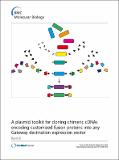Por favor, use este identificador para citar o enlazar a este item:
http://hdl.handle.net/10261/81310COMPARTIR / EXPORTAR:
 SHARE SHARE
 CORE
BASE CORE
BASE
|
|
| Visualizar otros formatos: MARC | Dublin Core | RDF | ORE | MODS | METS | DIDL | DATACITE | |

| Campo DC | Valor | Lengua/Idioma |
|---|---|---|
| dc.contributor.author | Buj, Raquel | - |
| dc.contributor.author | Iglesias, Noa | - |
| dc.contributor.author | Planas, Anna M. | - |
| dc.contributor.author | Santalucía, Tomàs | - |
| dc.date.accessioned | 2013-09-03T09:28:35Z | - |
| dc.date.available | 2013-09-03T09:28:35Z | - |
| dc.date.issued | 2013-08-20 | - |
| dc.identifier.citation | BMC Molecular Biology 14(1): 18 (2013) | es_ES |
| dc.identifier.issn | 1471-2199 | - |
| dc.identifier.uri | http://hdl.handle.net/10261/81310 | - |
| dc.description | This is an open access article distributed under the terms of the Creative Commons Attribution License. | - |
| dc.description.abstract | [Background]: Valuable clone collections encoding the complete ORFeomes for some model organisms have been constructed following the completion of their genome sequencing projects. These libraries are based on Gateway cloning technology, which facilitates the study of protein function by simplifying the subcloning of open reading frames (ORF) into any suitable destination vector. The expression of proteins of interest as fusions with functional modules is a frequent approach in their initial functional characterization. A limited number of Gateway destination expression vectors allow the construction of fusion proteins from ORFeome-derived sequences, but they are restricted to the possibilities offered by their inbuilt functional modules and their pre-defined model organism-specificity. Thus, the availability of cloning systems that overcome these limitations would be highly advantageous. [Results]: We present a versatile cloning toolkit for constructing fully-customizable three-part fusion proteins based on the MultiSite Gateway cloning system. The fusion protein components are encoded in the three plasmids integral to the kit. These can recombine with any purposely-engineered destination vector that uses a heterologous promoter external to the Gateway cassette, leading to the in-frame cloning of an ORF of interest flanked by two functional modules. In contrast to previous systems, a third part becomes available for peptide-encoding as it no longer needs to contain a promoter, resulting in an increased number of possible fusion combinations. We have constructed the kit’s component plasmids and demonstrate its functionality by providing proof-of-principle data on the expression of prototype fluorescent fusions in transiently-transfected cells. [Conclusions]: We have developed a toolkit for creating fusion proteins with customized N- and C-term modules from Gateway entry clones encoding ORFs of interest. Importantly, our method allows entry clones obtained from ORFeome collections to be used without prior modifications. Using this technology, any existing Gateway destination expression vector with its model-specific properties could be easily adapted for expressing fusion proteins. | es_ES |
| dc.description.sponsorship | The authors also thank the Unit of Information Resources for Research (URICI-CSIC) for the co-financing of this publication in Open Access. | - |
| dc.description.sponsorship | This work was supported by grants from the Spanish Ministry of Innovation and Science through FEDER funds (SAF2008-04515-CO2-02 and SAF2011-30492). T. S. is a participant of the “Programa d’ estabilització d’ investigadors de la Direcció d’ Estratègia i Coordinació del Departament de Salut” from the “Generalitat de Catalunya” , Spain. We thank the Unit of Scientific Information Resources for Research (URICI) at CSIC for their support on the publication fee through their Open Access Publication Support Initiative. | - |
| dc.language.iso | eng | es_ES |
| dc.publisher | BioMed Central | es_ES |
| dc.relation.isversionof | Publisher's version | - |
| dc.rights | openAccess | es_ES |
| dc.subject | Gateway cloning | es_ES |
| dc.subject | Fusion protein | es_ES |
| dc.subject | Combinatorial | es_ES |
| dc.subject | Fluorescent protein | es_ES |
| dc.subject | Epitope tag | es_ES |
| dc.title | A plasmid toolkit for cloning chimeric cDNAs encoding customized fusion proteins into any Gateway destination expression vector | es_ES |
| dc.type | artículo | es_ES |
| dc.identifier.doi | 10.1186/1471-2199-14-18 | - |
| dc.description.peerreviewed | Peer reviewed | es_ES |
| dc.relation.publisherversion | http://dx.doi.org/10.1186/1471-2199-14-18 | - |
| dc.contributor.funder | CSIC - Unidad de Recursos de Información Científica para la Investigación (URICI) | - |
| dc.identifier.pmid | 23957834 | - |
| dc.type.coar | http://purl.org/coar/resource_type/c_6501 | es_ES |
| item.openairetype | artículo | - |
| item.openairecristype | http://purl.org/coar/resource_type/c_18cf | - |
| item.grantfulltext | open | - |
| item.fulltext | With Fulltext | - |
| item.languageiso639-1 | en | - |
| item.cerifentitytype | Publications | - |
| Aparece en las colecciones: | (IIBB) Artículos | |
Ficheros en este ítem:
| Fichero | Descripción | Tamaño | Formato | |
|---|---|---|---|---|
| A plasmid toolkit.pdf | 1,19 MB | Adobe PDF |  Visualizar/Abrir |
CORE Recommender
PubMed Central
Citations
4
checked on 20-abr-2024
SCOPUSTM
Citations
9
checked on 23-abr-2024
WEB OF SCIENCETM
Citations
8
checked on 23-feb-2024
Page view(s)
334
checked on 23-abr-2024
Download(s)
279
checked on 23-abr-2024
Google ScholarTM
Check
Altmetric
Altmetric
Artículos relacionados:
NOTA: Los ítems de Digital.CSIC están protegidos por copyright, con todos los derechos reservados, a menos que se indique lo contrario.
